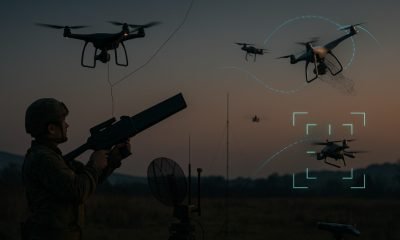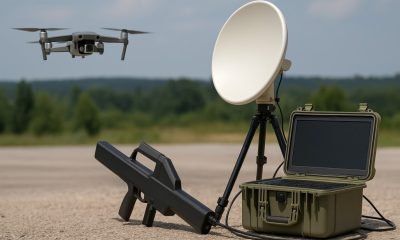Drone News
Environmental Monitoring with Drones

Environmental Monitoring with Drones Powered by AI
The advent of “Environmental Monitoring with Drones” has marked a significant transformation in the realm of environmental studies and conservation. The integration of drones in the environmental sphere has made the surveillance, analysis, and protection of ecosystems more precise, less intrusive, and considerably more efficient.
Historical Overview of Environmental Monitoring
Historically, environmental monitoring was a labor-intensive task that involved field surveys, sample collection, and manual data analysis. While these methods are still in use, they often provide a limited understanding of environmental conditions due to their spatial and temporal constraints. They can also be time-consuming and costly.
However, with the integration of drone technology, environmental monitoring has become more dynamic and insightful. Drones, equipped with an array of sensors and advanced imaging technology, provide researchers with an unparalleled ability to monitor, measure, and evaluate environmental conditions.
Integration and Impact on the Industry
The use of drones for environmental monitoring has brought about a revolution in data collection and analysis. Drones, armed with various sensors, can capture high-resolution images, thermal readings, air quality measurements, and much more. When combined with Artificial Intelligence (AI) and machine learning technologies, these drones can analyze the collected data in real-time, providing vital information about environmental conditions and changes.
This technological shift has facilitated a greater understanding of diverse ecosystems, from tropical rainforests to polar ice caps. The speed and mobility of drones also allow for rapid response to environmental emergencies, such as forest fires or oil spills, providing real-time data that can guide effective mitigation strategies.
Key Players and Current Utilization
Several tech companies have risen to the forefront in the field of environmental monitoring with drones. DJI, Parrot, and senseFly, among others, manufacture drones specifically designed for environmental monitoring, equipped with state-of-the-art sensors and imaging technology.
Organizations worldwide are employing these drones for various environmental monitoring applications. For instance, The Nature Conservancy uses drones to monitor elephant populations in Africa, while researchers in Antarctica employ drones to study ice melting patterns.
The AI Technology Powering Drone-Based Environmental Monitoring
Artificial intelligence (AI) is the cornerstone of modern environmental monitoring with drones. Advanced machine learning algorithms, data processing techniques, and AI-powered sensor technology have made it possible for drones to monitor and analyze the environment with incredible accuracy and efficiency.
Machine Learning and Data Interpretation
Machine learning, a subset of AI, is at the heart of drone data analysis. Drones equipped with sensors capture a vast array of environmental data, including visual, thermal, chemical, and spectral data. Machine learning models process this information, identifying patterns and trends that would be impossible for human analysts to discern manually.
For instance, machine learning algorithms can be trained to recognize signs of environmental change or distress, such as changes in vegetation patterns, the presence of pollutants, or alterations in wildlife behavior.
Computer Vision and Image Recognition
Computer vision is another essential component of AI-driven environmental monitoring. This technology enables drones to interpret visual data effectively.
For example, computer vision can help identify specific animal species, count individual animals within herds, or detect changes in land or water bodies. This information can be used to monitor wildlife populations, track land use changes, or assess the health of aquatic systems.
AI-Powered Sensors
Drones used in environmental monitoring are often equipped with a variety of AI-powered sensors. These may include multispectral sensors, thermal cameras, and air quality sensors, among others.
These sensors gather detailed data about the environment, which is then analyzed using AI algorithms. For instance, multispectral sensors can detect changes in plant health, while thermal cameras can identify areas of heat or cold in the environment.
Autonomous Navigation and Real-Time Analysis
AI also enables drones to autonomously navigate complex environments and adjust their flight paths based on real-time data. This functionality is vital in dynamic environmental conditions, such as in the event of a wildfire or during wildlife tracking.
In addition to navigation, AI allows for real-time data analysis. Drones can analyze environmental data as it’s gathered and make decisions based on this information, such as altering their flight path to further investigate an area of interest.
The Future of Environmental Monitoring with Drones
The future of environmental monitoring with drones looks promising. As AI and drone technology continue to advance, their potential for environmental monitoring will only expand. Drones could be used to monitor and combat climate change on a global scale, tracking greenhouse gas emissions, melting glaciers, deforestation rates, and more.
Also, improvements in drone endurance and the miniaturization of high-quality sensors will enable long-duration monitoring missions in challenging environments. This technology could provide an unprecedented understanding of our planet’s health and inform strategies to protect and preserve it.
Conclusion
“Environmental Monitoring with Drones” is a transformative shift in how we approach the study and conservation of our natural world. As drone and AI technology continue to evolve, we can expect even more detailed and rapid environmental monitoring, enabling us to respond to environmental challenges with unprecedented speed and precision.











